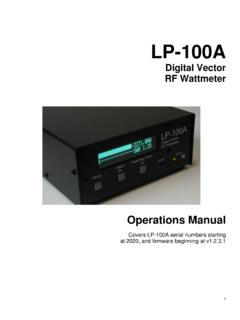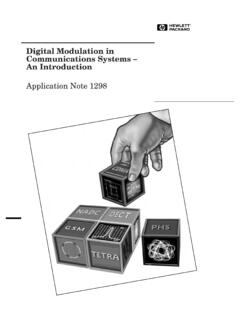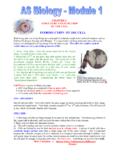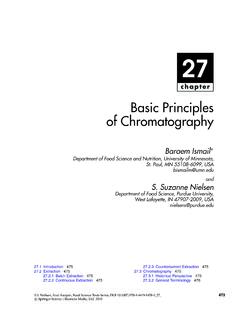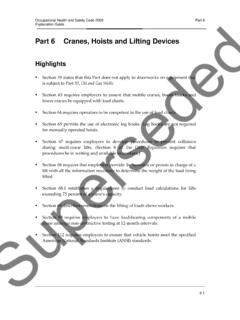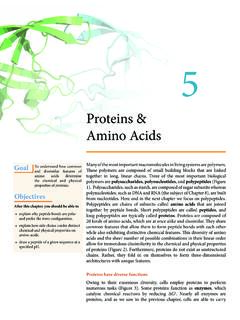Transcription of Lecture 9 Analog and Digital I/Q Modulation
1 11/4/2006 Analog I/Q Modulation Time Domain View polar View Frequency Domain ViewDigital I/Q Modulation Phase Shift Keying ConstellationsLecture 9 Analog and Digital I/Q ModulationL11/4/20062 Lecture 9 Fall 2006 Coherent Detection Requires receiver local oscillator to be accurately aligned in phase and frequency to carrier sine wave2cos(2 fot)y(t)2cos(2 fot)z(t)Lowpassr(t)Transmitter OutputReceiver Outputx(t)y(t)0L11/4/20063 Lecture 9 Fall 2006 Impact of Phase Misalignment in Receiver Local Oscillator2cos(2 fot)y(t)z(t)Lowpassr(t)Transmitter OutputReceiver Outputx(t)y(t)02sin(2 fot)Output is zero Worst case is when receiver LO and carrier frequency are phase shifted 90 degrees with respect to each otherL11/4/20064 Lecture 9 Fall 2006 Analog I/Q Modulation Analog signals take on a continuous range of values (as viewed in the time domain) I/Q signals are orthogonal and therefore can be transmitted simultaneously and fully recoveredit(t)qt(t)2cos(2 f1t)2sin(2 f1t)ttBaseband Inputi(t)it(t)cos 2 f0t()sin 2 f0t()q(t)qt(t)yt(t)
2 L11/4/20065 Lecture 9 Fall 2006 polar View of Analog I/Q Modulationit(t)=i(t)cos 2 fot+0 ()qt(t)=q(t)cos 2 fot+90 ()=q(t)sin 2 fot()yt(t)=i2(t)+q2(t)cos 2 fot+ (t)()where (t)=tan 1q(t)/i(t) 180 < <180 it(t)qt(t)2cos(2 f1t)2sin(2 f1t)tti(t)it(t)q(t)qt(t)yt(t)cos 2 f0t()sin 2 f0t()L11/4/20066 Lecture 9 Fall 2006 polar View of Analog I/Q Modulation (Con t) polar View shows amplitude and phase of it(t), qt(t)and yt(t)combined signal for transmission at a given frequency f. Magnitude ofi(t) andq(t)vary with time, representing information in the Analog domain.
3 (t)q(t)i(t)i2(t)+q2(t)QIQIi(t)i2(t)+q2(t )q(t) (t)y(t)y(t)L11/4/20067 Lecture 9 Fall 2006 Frequency Domain View of Analog I/Q Modulation Takes advantage of coherent receiver s sensitivity to phase alignment with transmitter local oscillator We have two orthogonal transmission channels (I and Q) available to us Transmit two independent baseband signals (I and Q) with two sine waves in quadrature at transmitterTransmitter Outputf-fofo011f0f-f1f10j-j2cos(2 f2t)2sin(2 f2t)y(t)it(t)qt(t)It(f)Qt(f)f0f-fofo0111 1f-fofo0j-jYi(f)Yq(f)2cos 2 f0t()2sin 2 f0t()-fofoQ(f)I(f)It(f)Qt(f)i(t)q(t)L11/ 4/20068 Lecture 9 Fall 2006 Analog I/Q Modulation -Transceiver I/Q signals take on a continuous range of values (as viewed in the time domain) Used for AM/FM radios, television (non-HDTV), and the first cell phones Newer systems typically employ Digital Modulation insteadReceiver Output2cos(2 f1t)2sin(2 f1t)Lowpassir(t)Lowpassqr(t)it(t)qt(t)2c os(2 f1t)2sin(2 f1t)ttttBaseband Input2cos 2 f0t()2sin 2 f0t()2cos 2 f0t()2sin 2 f0t()
4 L11/4/20069 Lecture 9 Fall 2006I/Q Transceiver Frequency Domain View Demodulate using two sine waves in quadrature at receiver Must align receiver LO signals in frequency and phase to transmitter LO signals Proper alignment allows I and Q signals to be recovered as shownTransmitter Outputf-fofo011f0 Receiver Outputf-f1f10j-j2cos(2 f1t)2sin(2 f1t)y(t)Lowpassir(t)Lowpassqr(t)2cos(2 f2t)2sin(2 f2t)y(t)it(t)qt(t)It(f)Qt(f)f0f-fofo0111 1f-fofo0j-jYi(f)Yq(f)f-fofo011f-f1f10j-j f0Ir(f)Qr(f)f0222cos 2 f0t()2sin 2 f0t()2cos 2 f0t()2sin 2 f0t()fofo-fo-foL11/4/200610 Lecture 9 Fall 2006 Impact of 90 Degree Phase Misalignment I and Q channels are swapped at receiver if its LO signal is 90 degrees out of phase with transmitter However, no information is lost!
5 Can use baseband signal processing to extract I/Q signals despite phase offset between transmitter and receiverTransmitter Outputf-fofo011f0 Receiver Outputf-f1f10j-j-2cos(2 f1t)2sin(2 f1t)y(t)ir(t)qr(t)2cos(2 f2t)2sin(2 f2t)y(t)it(t)qt(t)It(f)Qt(f)f0f-fofo0111 1f-fofo0j-jYi(f)Yq(f)f-fofo0-1-1f-f1f10j -jf0Ir(f)Qr(f)f0-22L11/4/200611 Lecture 9 Fall 2006 Digital I/Q Modulation I/Q signals take on discrete values at discrete time instants corresponding to Digital data+io iot+qo qotBaseband Inputit(t)qt(t)2cos(2 f1t)2sin(2 f1t)ttit(t)qt(t)yt(t)2cos(2 fot)2sin(2 fot)i(t)q(t)L11/4/200612 Lecture 9 Fall 2006 polar View of Digital I/Q Modulationi(t)and q(t)have discrete values.
6 In this case, binary values. io qoit(t)= iocos 2 fot()qt(t)= qosin 2 fot()yt(t)=io2+qo2cos 2 fot+ (t)()where (t)=tan 1 qo io Q io+ioI Q+qo qoIPolar View shows amplitude and phase of it(t), qt(t)and yt(t)combined signal for transmission at a given frequency (t)qt(t)L11/4/200613 Lecture 9 Fall 2006 polar View of Digital I/Q Modulation (cont d)Transmission signal is sine wave at frequency f0with information encoded in discrete values of amplitude and phase. 45 io2+qo2QI4 QAMQ uadratureAmplitude ModulationGiven io=qo=1yt(t)=2 (t)can have4values45 , 135 , 45 , 135 it(t)qt(t)2cos(2 f1t)2sin(2 f1t)ttit(t)qt(t)yt(t)2cos(2 fot)2sin(2 fot)i(t)q(t)L11/4/200614 Lecture 9 Fall 2006 Digital Modulation : 16-QAM I/Q signals take on discrete values at discrete time instants corresponding to Digital data I/Q signals may be binary or multi-bit Multi-bit shown above (4 levels each)it(t)qt(t)2cos(2 f1t)2sin(2 f1t)ttBaseband InputL11/4/200615 Lecture 9 Fall 2006 Constellation Diagram.
7 16-QAM We can view I/Q values at sample instants on a two-dimensional coordinate system Decision boundaries mark up regions corresponding to different data values Gray coding used to minimize number of bit errors that occur if wrong decisions made due to noiseDecisionBoundariesIQDecisionBoundar ies0001111000011110L11/4/200616 Lecture 9 Fall 2006 Advantages of Digital Modulation Allows information to be packetized Can compress information in time and efficiently send as packetsthrough network In contrast, Analog Modulation requires circuit-switched connections that are continuously available Inefficient use of radio channel if there is dead time in information flow Allows error correction to be achieved Less sensitivity to radio channel imperfections Enables compression of information More efficient use of channel Supports a wide variety of information content Voice, text and email messages, video can all be represented as Digital bit streams










